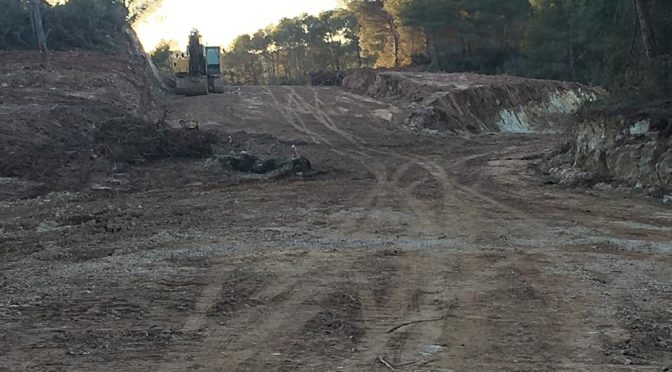Views: 1438
Excavation works have begun in Son Parc urbanisation, Es Mercadal. This project is a clear reminder of the long, intense battles Menorca has had to wage to combat the dangerous threats to its territorial integrity, inherent in the development plans of the 1970s. It also highlights the complicated impacts on any areas which are earmarked for development. It is only 3 years since the last attempt to promote this type of development.
The Provincial Plan, launched some 40 years ago, with its proposals for roads to circumnavigate the entire island and for the majority of the coast to be urbanised, resulted in important protests and the creation of GOB on the island.
Unique sites which today are emblematic, such as Trebalúger, Macarella, the Albufera of Es Grau, La Vall, Pregonda and many more, were all earmarked for development.
In various places the urbanisation process became reality, as in the case of Son Parc. The name Son Parc is the commercial denomination of the urban development in Son Saura on the North coast. Alarm bells started ringing in 1972, when the area was declared a Centre of National Touristic Interest, a pre-democratic designation unilaterally bestowed by the Council of Ministers. Capacity for 21,200 tourist beds was proposed at a time when Mercadal was a small town of fewer than 3,000 inhabitants.
The combined demand for sand generated by the development of the golf course and the construction boom, meant that a large proportion of the spectacular sand dunes, for which the area was well known, disappeared into the back of construction lorries.
In 1990 the tourist development plan for the area was reviewed. It had become evident that the original growth projections were unachievable and capacity was reduced to 12,000 potential beds.
At the end of the 90s an attempt was made to expand the golf course (which only had 9 holes). To do this it was proposed to drain the wetlands of Son Saura. The local Council gave its approval but GOB raised legal objections and managed to block the project. Restoration work on the affected area duly followed.
By the time the ‘precautionary rule’ was introduced, the Son Parc developers had completed 4,000 beds. Subsequently the Island Territorial Plan was adopted and, as a result of its analysis work, a further reduction of capacity was proposed: from the 8,000 beds yet to be built, to just 2,800.
In 2007, after intense negotiations, the developers accepted the reduction in capacity proposed by the ITP and signed the agreement. In 2014 the urbanisation project was definitively approved.
47 years on:
1972 to 2019 is 47 years. Forty-seven years during which we’ve been trying to get our heads around the disastrous mess that was launched decades ago. Even after all the capacity reductions, more building can still be done including: 4 hotels, 490 chalets, a sports centre and a shopping mall. These are the building works for which the woods are now being destroyed.
Time has shown that undeveloped beaches, in addition to ensuring a good quality of life and being a source of pride for Menorcans, are also a strong tourist attraction. An intelligent economic model is one that uses its land in a sustainable fashion rather than by over developing it.
Even today, the original plans have the potential to further impact the island. Menorca has many plots of land that were authorised for building and this could happen if the authorisations are not revoked.
Nonetheless it seems that the lesson has still not been learned. To take one example: The Transitory Territorial Rule, that was applied to the island in 2015 and which the subsequent government left in place, established a 100 metre rule to allow the development of coastal urbanisations. It also backed the development of golf courses with their own hotels. This was only four years ago.
The example of Son Saura and its urbanisation Son Parc, should serve as a clear demonstration of how easy it is to designate large swathes of land for urban development and how difficult it is to reverse the process. And the consequences are irreversible.

